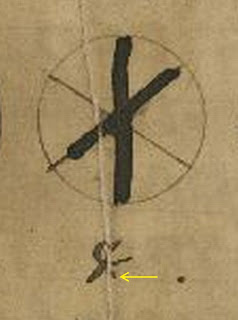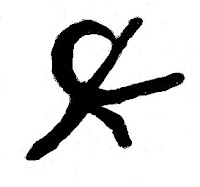Reconstruction of words in RUN-script OLB (from page 46).
The "run"-script has always been considered as typical 19th century, but this is not at all evident.
Specially the F is not like any Dutch handwriting I have ever seen.
It actually looks more like a Greek Phi.
For some letters it is obvious that they look like the Greek version, for example, K, U and T.
But if you have a better look at the L, you can see how it may have evolved (through the 'run'-version) into the Greek Lambda.
So:
Jol-F => run-F => Greek F
Jol-L => run-L => Greek L
This trick does not apply for all letters, but that it does for some of them is, at least, remarkable.
===
Edit: after I posted I noticed that the Greek L is a mirrored version of the L that I made, based on the run-L (which is like the traditional capital L).
======
How do you interpret that dot?
Do you believe it is part of the letter?
How would you reconstruct the letter?
Can you make a drawing of what you think it should be?
Abramelin:
I know it looks like sh1t, but either the one copying the MS had some problems with his quill, or this is how the letter should look.
Otharus:
The whole point about the RUN-script is that one can write fast and keep the pen on the paper as much as possible, so the ink can flow gently without making a mess. You will know if you have ever written with a dip-pen.
So I think your first guess is the right one, as this makes most sense IMO:
(in the last one I have exaggerated to make the direction visible)
The "run"-script has always been considered as typical 19th century, but this is not at all evident.
Specially the F is not like any Dutch handwriting I have ever seen.
It actually looks more like a Greek Phi.
For some letters it is obvious that they look like the Greek version, for example, K, U and T.
But if you have a better look at the L, you can see how it may have evolved (through the 'run'-version) into the Greek Lambda.
So:
Jol-F => run-F => Greek F
Jol-L => run-L => Greek L
This trick does not apply for all letters, but that it does for some of them is, at least, remarkable.
===
Edit: after I posted I noticed that the Greek L is a mirrored version of the L that I made, based on the run-L (which is like the traditional capital L).
======
Abramelin, on 13 November 2012 - 01:29 PM, said:
How do you interpret that dot?
Do you believe it is part of the letter?
How would you reconstruct the letter?
Abramelin, on 13 November 2012 - 08:07 PM, said:
I think the dot is what remains of a little line connected to the main figure (letter).
Can you make a drawing of what you think it should be?
Abramelin:
I know it looks like sh1t, but either the one copying the MS had some problems with his quill, or this is how the letter should look.
Otharus:
The whole point about the RUN-script is that one can write fast and keep the pen on the paper as much as possible, so the ink can flow gently without making a mess. You will know if you have ever written with a dip-pen.
So I think your first guess is the right one, as this makes most sense IMO:
(in the last one I have exaggerated to make the direction visible)






No comments:
Post a Comment